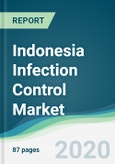The Indonesia infection control market is projected to grow at a CAGR of 9.70% over the forecast period 2019 to 2025 Federal agencies such as the Centers for Disease Control and Prevention (CDC) are making extreme and good efforts in Indonesia in order to accelerate the improvement of the country’s ability to effectively and timely detect, prevent, and respond to the outbreaks of infectious diseases so that they do not turn into epidemics. In addition, CDC is also engaged in working with the Ministry of Health (MOH) and providing their expertise to aid in the development of core public health facilities in disease and infection surveillance, emergency engagement among some other areas. Moreover, the programs such as the PASIMAS (Penyediaan Air Minum dan Sanitasi Berbasis Masyarakat or Community Based Drinking Water Supply and Sanitation) are increasingly involved and aimed towards the provision of clean and safe drinking water to the low-income and the rural population in Indonesia, so as to minimize the risk of serious infections and hospitalizations.
In addition, Indonesia is a participating country in the Global Health Security Agenda (GHSA), which was set in order to ensure that safer practices are being followed by medical institutions and other healthcare establishments in order to ensure that the infection can be controlled and prevented effectively. Some of the measures under this agenda include action packages for antimicrobial resistance and biosafety and biosecurity. As antimicrobial resistance occurs when the medications that are used to cure and control the infections are rendered infective due to the changing microorganisms such as bacteria, viruses, parasites among others, it is essential to have effective antimicrobials to prevent and control the infections, to minimize the spread of diseases. This action plan is aimed towards combating antimicrobial resistance by addressing the human and animal health, food production, and other aspects by following proper infection control procedures, and engagement and collaboration from multiple sectors. The biosafety and biosecurity action plan deals with the timely prevention and control of biological events that can endanger the public health if adequate preparedness is missing. In order to deal with this, the infrastructure and resources must be advanced with standard hygiene and disinfection techniques being followed.
Sterilization to increase its share over the next few years
Sterilization is projected to hold a significant share over the forecast period and increase its share over the next few years on account of the fact that there has been active participation of the Centers for Disease Control and Prevention and implementation of action plans such as the Global Health and Safety Agenda. This is to make the healthcare provider and caretakers aware of the risks of not following proper hand hygiene, environmental hygiene, infection control precautions, and continuous disinfection so that outbreaks of infections and diseases can be controlled timely and efficiently. In addition, one of the major players Tuttnauer, which has a global presence is involved in the provision of sterilization equipment such as washer-disinfectors, autoclaves, plasma disinfectors for laboratories, medical centers, dental clinics, and veterinary clinics. Thus, this factor is going to contribute to the increased adoption of sterilization equipment and aid in increasing the market share of sterilization equipment.
Segmentation
By Product
By End-User Industry
In addition, Indonesia is a participating country in the Global Health Security Agenda (GHSA), which was set in order to ensure that safer practices are being followed by medical institutions and other healthcare establishments in order to ensure that the infection can be controlled and prevented effectively. Some of the measures under this agenda include action packages for antimicrobial resistance and biosafety and biosecurity. As antimicrobial resistance occurs when the medications that are used to cure and control the infections are rendered infective due to the changing microorganisms such as bacteria, viruses, parasites among others, it is essential to have effective antimicrobials to prevent and control the infections, to minimize the spread of diseases. This action plan is aimed towards combating antimicrobial resistance by addressing the human and animal health, food production, and other aspects by following proper infection control procedures, and engagement and collaboration from multiple sectors. The biosafety and biosecurity action plan deals with the timely prevention and control of biological events that can endanger the public health if adequate preparedness is missing. In order to deal with this, the infrastructure and resources must be advanced with standard hygiene and disinfection techniques being followed.
Sterilization to increase its share over the next few years
Sterilization is projected to hold a significant share over the forecast period and increase its share over the next few years on account of the fact that there has been active participation of the Centers for Disease Control and Prevention and implementation of action plans such as the Global Health and Safety Agenda. This is to make the healthcare provider and caretakers aware of the risks of not following proper hand hygiene, environmental hygiene, infection control precautions, and continuous disinfection so that outbreaks of infections and diseases can be controlled timely and efficiently. In addition, one of the major players Tuttnauer, which has a global presence is involved in the provision of sterilization equipment such as washer-disinfectors, autoclaves, plasma disinfectors for laboratories, medical centers, dental clinics, and veterinary clinics. Thus, this factor is going to contribute to the increased adoption of sterilization equipment and aid in increasing the market share of sterilization equipment.
Segmentation
By Product
- Disinfectant
- Sterilization
- Low-Temperature Sterilization
- Heat Sterilization
- Contract Sterilization
By End-User Industry
- Healthcare
- Food and Beverage
- Chemical
Table of Contents
1. Introduction
2. Research Methodology
3. Executive Summary
4. Market Dynamics
5. Indonesia Infection Control Market By Product
6. Indonesia Infection Control Market By End-User Industry
7. Competitive Intelligence
8. Companies Mentioned
Companies Mentioned
- Drägerwerk AG & Co. KGaA
- 3M
- B. Braun Melsungen AG
- Tuttnauer
- BD
Methodology

LOADING...








